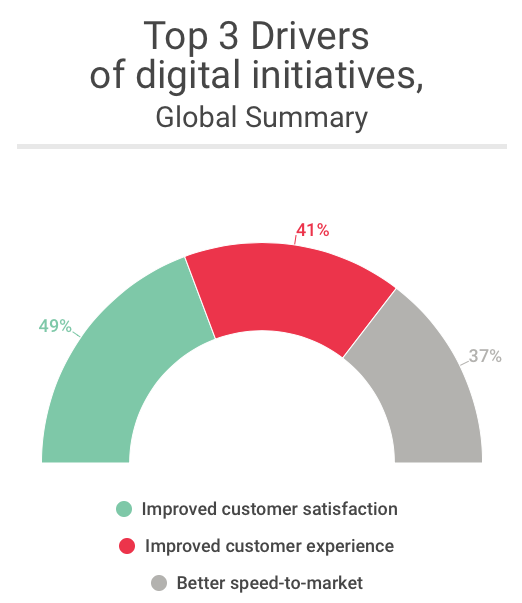-
No-Code
Platform
-
Studio
No-code agentic platform delivering the fastest time-to-value and the highest ROI
-
Studio
-
AI-Native CRM
CRM
-
AI-Native CRM
New era CRM to manage customer & operational workflows
CRM Products -
AI-Native CRM
- Industries
- Customers
- Partners
- About
3 key insights on digital transformation from B2B leaders
10/09/2017
5 min read
You are either a native digital business, or you are facing digital transformation - there isn’t really a third option in such a fast paced business environment. Having a common problem hasn’t translated to a common understanding of what digital transformation means exactly, and how to execute it.
In this post we’re going to break down experiences of the best-of-breed that faced a real Digital Transformation...and absolutely Nailed It!
First off, what are the reasons that forced companies to undertake this fundamental change:
-
ineffective old-school marketing
-
disconnected teams and processes
-
shifted consumer demand
-
limits in customer reach
-
inconsistent customer service
-
losing revenue
-
fear of failure
So, basically, it had become more of a necessity for businesses to become digital, than a choice.What’s more, the whole transformation process was focused on clients, their needs, and expectations. And technology became the main weapon in bringing this strategy to life.
And that’s what we’ve learned:
-
total focus on the client;
-
all teams work for a single goal- customer satisfaction;
-
provision of effortless brand experience through various digital channels;
-
redefined value propositions;
-
continuous innovations and agility;
-
grabbing insights from behavioral user data;
-
technologies everywhere for enhanced performance.
They are global leaders now sharing the most impactful choices that brought ‘em to the top. And we’re happy to spread these insights to help you get to the top of your market. So enjoy!
-
CloudFlare “Be Customer-Obsessed”
Our first respondent provides cloud solutions for businesses internationally helping enhance the performance of their websites and building up cyber security at the same time.
Having been recognized as a Technology Pioneer by the World Economic Forum back in 2012, they continue to grow rapidly adding 20,000 new clients a day. What’s more, such whales like Cisco, Nasdaq, Uber, and Fitbit are already flaunting in their portfolio.
How does CloudFlare do that?
Starting from the core idea, their business approach to the quality of service and the most effortless user experience provided, CloudFlare has religiously been centering the biz around the needs and benefits of their clients.
Did you know that around 95% of their users take advantage of CloudFlare’s free subscription plan? And that’s around 2 million websites. Believe it or not, basic version of the service offers quite a solid range of features to boost and secure diverse websites. At the same time, only 4 to 5% of their audience opt to pay between $20 and $5,000 for the extended subscription.
On top of that, CloudFlare makes sure the visitor learns how to use their service in a matter of minutes. There is a true multitude of info that guides you through essential first steps (Welcome Center), reveals various aspects of the service (Blog and Webinars), allows to share experience and ask questions on the matter (Community) and even explains how to build an app or integration on CloudFlare (Developer Hub). And all that without a need for real-time communication with anyone. Ninety-five percent of questions are covered in their knowledge base.
Despite being often targeted for protecting controversial sites, they still preach free speech values and protect their customers’ confidential data from the law enforcement agencies that request it from CloudFlare. They don’t hesitate to disclose the details of the queries in the semi-annual Transparency Reports - to ensure clients that the company owning all their strategical digital data is on their side.
So yeah, CloudFlare chooses “to be a soldier not complaining about being shot at” as Matthew Prince, CEO of CloudFlare states. But they also choose to be a reliable, invisible and helpful partner for digital businesses of all shapes and sizes around the globe. And we find it a real killer combo to learn from!
The latest Digital Transformation Study from CA Technologies totally supports this idea. After surveying global leaders in various industries, they got us covered on what’s influencing their business strategies nowadays:

-
Intel “Continuous innovations is the way to go”
Intel is a long-living giant in IT business world. It’s the largest semiconductor manufacturer in the world and one solid example of remaining trendy for decades in the high technologies market.
Their way of staying at the very top of the market is the result of introducing innovations nonstop.
Not only is Intel a major evangelist of IoT (Internet of Things), keen on connecting them all to the cloud for the sake of secure data management, faster time to market and solving a range of customers’ business problems. They also help industries like machine building, energy and healthcare eliminate burning problems.
How does Intel do that?
Mixing customer-centricity with innovations, Intel develops literally life-saving IoT solutions for transportation that already have helped boost fuel efficiency, increase overall safety and reliability of commercial vehicles. For healthcare in India, they help reduce treatment time and curing costs while increasing the quality of services. Also in Malaysia, Intel’s inventions have helped increase overall farm crop for the Government as well as cattle productivity.
Important note! The very heart of Intel’s uninterrupted innovations is their virtual R&D center managed within CRM. This helps structure, run and optimize all processes and communication for the sake of seeing those awesome ideas through and delivering them as fast as possible.
Staying up to date with your internal processes is also highly important. Your best talents are most likely to quit if you don’t provide them environment for developing digital skills):
-
Amazon “Automize & align your processes to the fullest”
This huge American marketplace has extended the customer-friendly approach to the enterprise level, focusing on the consistent improvement of customer experience. They took a challenge of taking the most effortless B2C e-commerce pattern onto the B2B business model. And didn’t go wrong with it.
How does Amazon do that?
From the outset, Amazon was aiming at maximum process automation. They’ve built their own CRM and have been using it for a myriad of purposes from data collection, customized recommendations to dealing with customer requests. They use all collected data to drive sales, improve the quality and timing of the service and investigate rooms for business expansion.
Again, this success story is well backed by other leading companies witnessing the long run benefits of biz processes automation:
Concluding thoughts
It’s getting obvious that successful companies focus their activities around the customers from the onset. And what’s even more important is they take full advantage of their customer data with the help of automation tools. The best part for us is that every single advice insight shared in this post is scalable and applicable to the companies of all shapes and sizes.
Start being like a CloudFlare, Intel and Amazon - become your industry rock star:
-
Customer Obsession - it’s your way to market leadership. In this highly competitive global market, serving your clients best should be your first priority. Satisfied clients will continue coming back and do the word-of-mouth hype (the most effective and free for you type of advertising);
-
Continuous Innovations - digital era is here, everybody is curious about new technologies showing up here and there. Customers want new innovative things. It’s high time to study your clients in perfect detail and offer something they’d really love;
-
Complete Automatization - being customer-centered and innovating are only possible when processes are automatized. There is so much useful info audiences provide by online behavior alone. Capture those bits, analyze them and use to create new helpful and exciting products.




















































